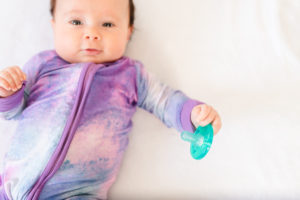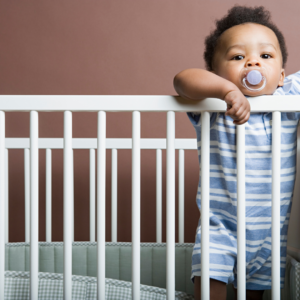Pacifiers and sleep are a HOT topic. It seems as though some babies have a pacifier in their mouths all day long, some parents don’t want their little ones to get attached to their pacifier so they never use one at all, and most other people are somewhere in between.
As a sleep consultant, I talk about pacifier usage ALL THE TIME, so I want to break it down for you in this blog post. We will talk about:
- When I suggest parents use pacifiers for sleep (hint: for newborns!)
- When I suggest parents stop offering the pacifier for sleep
- How pacifiers can actually hinder your little one’s sleep
- How to wean your baby or toddler from the pacifier
And more!
When to Use Pacifiers For Sleep
Pacifiers are great for newborns
When babies are first born, they have a physical need to suck – it’s called “non-nutritive sucking,” and that need makes pacifiers GREAT for newborns! Nursing or bottle feeding certainly help meet this physical need, but sometimes a newborn is not hungry but simply needs to suck on something, and a pacifier is just the tool.
Additionally, as newborns have two underdeveloped sleep cycles and don’t yet have the ability to self-soothe, pacifiers can be really helpful in soothing a newborn to sleep. My general rule of thumb is to not make the pacifier the first plan of action when trying to get your newborn to sleep, but to have it as an option when other soothing methods aren’t working.

Use pacifiers if you want to!
As a sleep consultant, my job is to step in and help families when they ask for it. But I always tell people, if what you’re currently doing works for you, your child, and your family, that’s great! So if your baby or toddler uses a pacifier for every nap and bedtime and that works for you, I’m so thankful.
When to Stop Using the Pacifier For Sleep
Although pacifiers are great for newborns, I recommend pulling that pacifier completely away from sleep by about four months old, if your goal is to help your baby sleep more independently. At four months old, a baby’s sleep cycles have adjusted and are now more mature, adult-like cycles, and they now have the ability to learn to self-soothe. So we can start teaching our babes to fall asleep without needing a pacifier to suck on!
Now I know what you’re wondering…do we have to pull the pacifier away during the day, too? The short answer is no, you don’t! I totally understand wanting to keep a pacifier on hand for the road trip where your baby just won’t fall asleep, or for the church service where they’re happily squealing away and you want to be a bit more quiet. Sure, keep the pacifier, but make sure your child isn’t using it too close to sleep time (read further, for more info).
The temptation here, however, is that it will keeping creeping closer and closer to sleep, and eventually you’ll be back at square one. So if you do keep the pacifier around, I would keep them out of your child’s room altogether and try to use them sparingly.
So let’s dig into why I recommend taking the pacifier away from sleep at four months old.
How Pacifiers Can Hinder Your Child’s Sleep
Pacifiers are a sleep prop
First, pacifiers are a sleep prop – something outside of a child that they rely on in order to fall and stay asleep. The trouble with sleep props, however, is that relying on certain sleep props, such as feeding, rocking, or using a pacifier, prevents babies and children from becoming independent sleepers.
When families are looking to teach their babies and children to fall asleep on their own and sleep through the night (once physically ready), it’s important that we remove those sleep props so they can naturally connect sleep cycles during naps and night time.
I know what some of you are thinking…your child is able to fall asleep independently, with the pacifier, and sleep through the night. And if the pacifier falls out, they simply grab it and put it back in their mouth. So what’s the problem?
Like I said before, if the way your little one currently sleep works for you, that’s great! However, when I work with families, we always work on removing the pacifier from sleep when they’re four months or older, because I often see it get in the way.
I’ve worked with so many families who seem to have the “perfect” schedules, the “perfect” routines, they’ve sleep trained, and everything seems to be in the right place…BUT their little one still uses a pacifier for all sleep. And something just isn’t working, whether that’s long night wakings, early mornings, short naps, etc.
Let me explain some more…

Pacifiers can cause night wakings, early mornings, and short naps
Using a pacifier requires a physical response from babies and toddlers – they have to actively suck on it in order to keep it in their mouth. Because they require such a physical response, I have found that pacifiers can actually keep little ones in a lighter stage of sleep, making it easier for them to stir in the night, especially when the pacifier falls out.
This is why parents often get stuck having to pop back into their baby’s room multiple times throughout the night, because the pacifier fell out of their baby’s mouth and they need help replacing it. And that can be exhausting!
Additionally, whether a little one knows how to replace the pacifier themselves or not, it still breaks up their sleep. And the pacifier can actually make it that much harder to fall back asleep. One reason being, like I mentioned before, pacifiers require such a physical response from babies and toddlers to engage them. Can you imagine chewing gum while trying to fall asleep? That chewing would certainly keep you awake longer, and you’d probably stir and keep chewing every now and then.
“But if the pacifier falls out, my baby knows how to put it back in their mouth without needing help.”
This is a response I frequently get when I tell families my sleep training plans do not include a pacifier…
That’s definitely better than you having to replace it multiple times a night or nap, however your child is still getting more broken up sleep. For them to realize the pacifier fell out, sit up, roll around, find another one, turn it the right way, and get it in their mouth is a lot! We all experience natural night wakings, however those wakings are generally so brief we don’t even remember them in the morning because we simply go right back to sleep. And we’re looking for consolidated sleep.
“How are pacifiers any different than a blanket or a lovey?”
This is a another common question! Pacifiers require a physical action in order to “engage” them – your child has to suck on one to keep it in their mouth. And if it falls out, your child has to not only find that small pacifier, but figure out which way to put it in their mouth, and then suck on it to be able to use it.
A blanket, stuffed animal, or lovey, on the other hand, doesn’t require much response. Your child can cuddle up next to it, wrap their arm around it, even grasp it in their hands, but when they fall asleep, it’s still cuddled right next to them without any more action necessary. Plus, if they happen to “lose” it, stuffed animals and lovies are much bigger and easier to find than a small pacifier.
Pacifiers can also take off some sleep pressure pre-maturely
Another rule with keeping the pacifier for awake times is still keeping it away from sleep! It’s important that, if your baby still occasionally uses their pacifier during awake times, they no longer suck on it around 30 minutes before their nap or bedtime, and 30 minutes after they wake up in the morning or from a nap.
One, we want it totally removed from feeling like it’s connected to sleep, and two, we don’t want the pacifier taking off any sort of sleepy “edge” (sleep pressure!) that will help your little one both fall and stay asleep. Using the pacifier too close to sleep can make it harder to fall asleep for that nap or bedtime, or cause a short nap or night wakings to occur due to lack of sleep pressure.
How to Wean Your Baby or Toddler From Sleeping with a Pacifier
Take the Pacifier Away Cold Turkey
I know it might sound scary, or it might sound harsh, but I don’t suggest “weaning” a pacifier – removing the pacifier from your baby or toddler cold turkey is really the quickest and least confusing way to do so!
I suggest you take them all out of your baby’s nursery, make sure none have been left under your toddler’s bed or covers, and take them all out of your room, so they’re just not an option!
And then HAVE A PLAN for what you’re going to do when your baby or toddler is upset without it. How will you respond to their protest? When will you respond? What if they wake in the night, what will you do? (Hint hint: use the sleep training method you previously used or one that will work best for your child.) That consistency is so important!
Use a “Pacifier Fairy” or “Gift It”
For toddlers and older children who are more verbal and are able to enter a conversation, I’ve known some families who talk about how the “pacifier fairy” is going to come and take their pacifiers, and exchange them for a special gift (kind of like the tooth fairy). This lets the child know their pacifiers will soon be gone and can build some excitement about what’s to come.
Similarly, I’ve also known families who “wrap up” their child’s pacifiers and “gift them” to a family or friend having a baby, or to their new sibling.
I’ll be honest – while both of these ideas seem fun, I still think it’s confusing and can cause more challenges. What if your toddler doesn’t care about getting a new gift, they just want their pacifier? Or what if they don’t fully understand that gifting their pacifiers means they’re gone forever? It just kind of seems confusing.
Let’s just be honest with our kiddos about how now it’s time to learn to sleep without a pacifier and we’ll help them do it, and soon they won’t even remember how attached they were in the first place.
Conclusion
If you’re looking to sleep train your little one, whether four months old, 14 months old, or 4 years old, I suggest saying goodbye to that pacifier! Think about it…if you “sleep train” your little one at 6 months old (with the pacifier), you’re going to eventually have to take it away and there will likely be some sleep training that has to happen again to actually remove it altogether.
Also, you may sleep train with a pacifier only to find it doesn’t actually fully work, and then you have to take it away anyway. So if you’re going to sleep train, let’s sleep train all the way, the right way, when you’re ready, so you don’t have to do it all over again a few months or years down the road when it’s time for the pacifier to go.
If even thinking about taking the pacifier away seems totally overwhelming and you just don’t know where to start, or if you know it’s time to take it away but you want some reassurance and accountability in doing so, that’s what we’re here for! Check out our coaching options so we can your family get the best sleep possible!
With Grace,
Lauren
